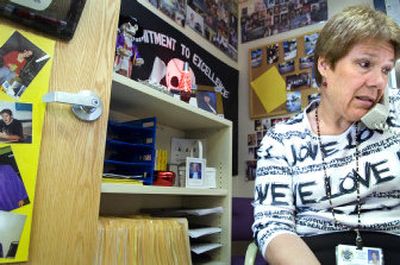Paying attention to intervention

Rogers High School senior Gregg Briscoe tried to sleep in Tuesday morning, but he wasn’t too successful.
He’d already missed third period when the school’s intervention specialist, Barb Farnsworth, came knocking on his front door telling him to get his butt to class.
“I’d have dropped out in the 10th grade if she didn’t help me out,” Briscoe said of Farnsworth.
Briscoe, 17, will graduate from high school this summer, a little late but better than not at all.
“These are the kids that will disappear into the wood if we let them,” Farnsworth said. “We can’t let these kids get away.”
Because of a new intervention program in place at the Spokane school, Briscoe is just one of students that Farnsworth and the staff at Rogers haven’t let “fall through the cracks.”
With the help of some grant funding, Farnsworth moved over in January 2005 to become a full-time intervention specialist at Rogers, where there are large numbers of students living in poverty.
A Rogers alumna, Farnsworth has been working with high-risk students at the school for 24 years, first as a teacher and now as an unofficial counselor. Her title is teacher on special assignment.
She spends her days poring over data, such as students’ grades, tracking where they’ve been, where they are going and what they need to be successful. Farnsworth is busy. Rogers has a large population of students from low-income families. About 68 percent, for example, qualify for free and reduced-price lunches.
The program also includes a system of interventions with students, followed by personalized plans to help those who are struggling in life and school.
“I’ve never been anywhere like this where people work so hard and are so thoughtful about each individual kid,” Assistant Principal Jim Fry said. “It’s allowed us to hold on to kids and find a way to meet their needs.”
Fry said the staff in November began to look at what other Spokane high schools were doing to reach struggling students in an effort to create something that would keep the mix of Rogers kids in school.
“Some of our kids are supporting entire families,” Fry said. “So how do we have a rigorous program while still meeting the needs of those students? Before, they would just drop out.”
So far this year, Farnsworth and the staff have held one-on-one meetings with 439 students in danger of failing or at risk of dropping out. Rogers has about 1,600 students.
Some of the programs put into place through the intervention system include a homework center and a program for freshmen who passed the seventh-grade WASL test, but were failing four or more classes in high school. The focus so far has been on ninth- and 10th-graders, with plans to include juniors and seniors as well.
But Farnsworth’s office, which is the size of a closet, is open to everyone.
Her walls are lined with the photographs of current and former students, and bumper stickers that say things like, “Don’t let our youth go to waste.”
Ask her about the faces in the photos, and she knows each by name. She’s not shy about pointing out problems, or praise. This one is a drug addict. That one went to college, and this one is serving time in prison for murder. That one is a talented musician who might make it big.
“So many of them come to us broken,” Farnsworth said. “The best we can do is to try and help them exist in their life; to help them recognize their potential and keep pushing them along.”